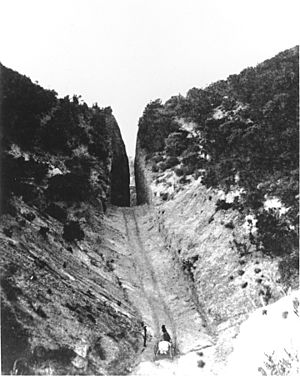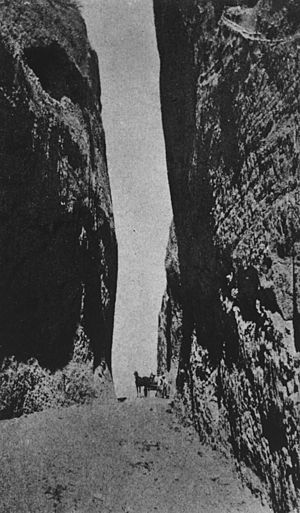Beale's Cut Stagecoach Pass facts for kids
Quick facts for kids Beale's Cut Stagecoach Pass |
|
|---|---|

Beale's Cut in 1872
|
|
| Location | Sierra Hwy and Clampitt Rd.Santa Clarita |
| Built | 1862 |
| Designated | May 11, 1992 |
| Reference no. | 1006 |
| Lua error in Module:Location_map at line 420: attempt to index field 'wikibase' (a nil value). | |
Beale's Cut Stagecoach Pass is a historic road cut built in 1859. It was also known by other names like Fremont Pass, San Fernando Pass, and Newhall Cut. Before this cut was made, the area was simply called the Newhall Pass.
This important pass was officially recognized as a California Historical Landmark (No. 1006) on May 11, 1992. It created a path through the mountains, connecting the San Gabriel Mountains and the Santa Susana Mountains. You can find it close to where Interstate 5 and California State Route 14 meet today.
Contents
Building the Famous Beale's Cut
The original mountain pass was very steep and hard to cross. To make travel easier, a deep, slot-like road was cut through the mountain. This work was done by Charles H. Brindley, Andrés Pico, and James R. Vineyard. The State of California gave them a special agreement. They could collect money (tolls) from travelers for twenty years to keep the road in good condition.
This new cut helped travelers get past the "San Fernando Mountain." This mountain was the toughest part of the Fort Tejon Road. This road was the main way to travel from Los Angeles to the north. Soon after it was built, the Butterfield Overland Mail started using it. This was a stagecoach service that delivered mail between St. Louis, Missouri, and San Francisco.
Edward Beale Takes Over
In 1861, a man named Edward Fitzgerald Beale became the federal Surveyor General for California and Nevada. This meant he was in charge of surveying land for the government. In 1863, Beale was given the right to collect tolls at the pass. He kept these rights for the next twenty years. Because of this, the pass became widely known as "Beale's Cut."
Edward Beale hired Chinese immigrants to do most of the hard work on the cut. The main construction was finished in 1863. However, the local government, the Los Angeles Board of Supervisors, officially accepted it as complete on March 5, 1864.
Challenges and Repairs
The winter of 1861–62 brought heavy damage to Beale's Cut. Wagons could not get through the pass because of the damage. In March 1862, soldiers helped fix the cut and the road. These soldiers were part of the Fifth California Volunteer Infantry. Their main base was Camp Latham, California.
The soldiers repaired the cut because it was important for moving supplies. Ammunition wagons needed to get through the pass to reach Fort Yuma, Arizona.
How Deep Was Beale's Cut?
Over time, Beale's Cut was made even deeper. It eventually reached about 90 feet (27.4 m) deep. It served as an important travel route near what is now Newhall Pass. However, its use for transportation ended when the Newhall Tunnel opened in 1910.
Beale's Cut in Movies
Beale's Cut became a popular spot for filming movies, especially silent westerns. Movie directors like John Ford and D. W. Griffith loved using this location.
In John Ford's 1923 film Three Jumps Ahead, the famous cowboy star Tom Mix was filmed jumping over the pass. People still debate whether Tom Mix actually made the jump himself. Many stuntmen claimed they did it, and some experts think special effects were used. John Ford used Beale's Cut in at least four of his films over a twenty-year period, starting as early as 1917.
Beale's Cut Today
Beale's Cut still exists today, but you cannot drive through it anymore. It was partly damaged during the Northridge Earthquake on January 17, 1994. Now, it is about 30 feet (9.1 m) deep.
You can see it from the Sierra Highway. It's about one mile north of where The Old Road and Sierra Highway meet, just after the first bridge under SR 14. It sits between Sierra Highway and the new freeway, about a quarter-mile northeast of a stone marker. Beale's Cut can be hard to find because it is fenced off and not very close to the Sierra Highway.
The Pass's Original Discovery
The pass was first discovered in August 1769 by a Catalan explorer named Gaspar de Portolá. Today, the pass is named after Henry Newhall, a businessman who lived in the area during the 1800s.
Replacing the Cut: The Newhall Tunnel
In 1910, the Newhall Auto Tunnel was built about a quarter-mile northwest of Beale's Cut. This tunnel was 435 ft (133 m) long and 17.5 ft (5.3 m) wide. Because it was narrow, two-way traffic through it was very slow.
The California Division of Highways decided to replace the tunnel. In July 1938, work began to remove the rock above the tunnel. This created a four-lane highway. This road was first called US Highway 6, then State Highway 14, and is now known as the Sierra Highway. The original cut for the tunnel is west of today's Highway 14.



